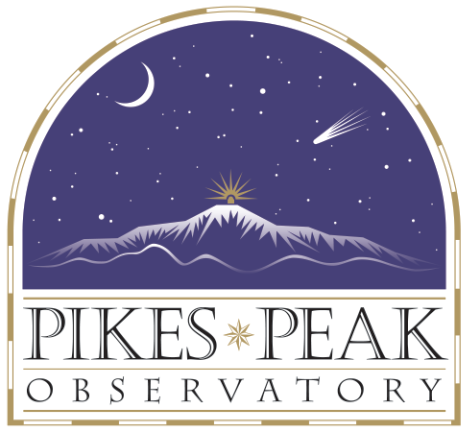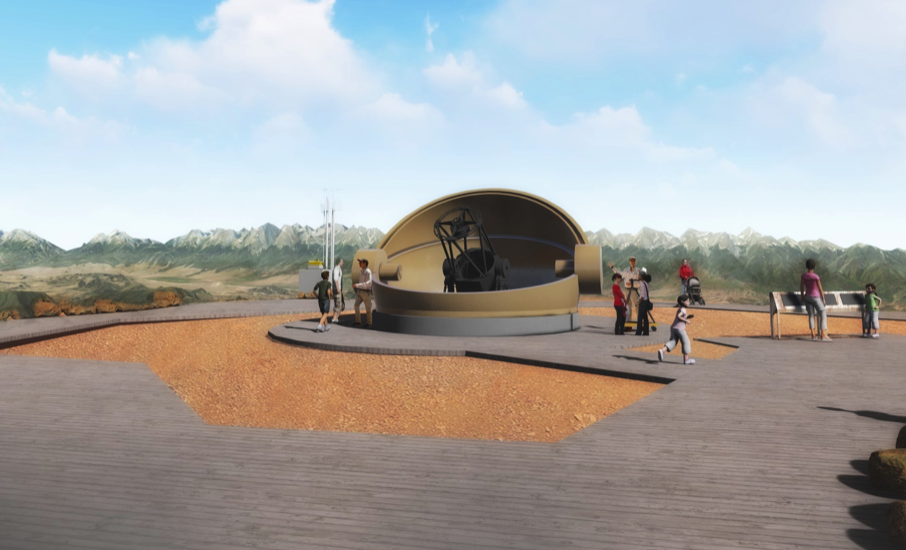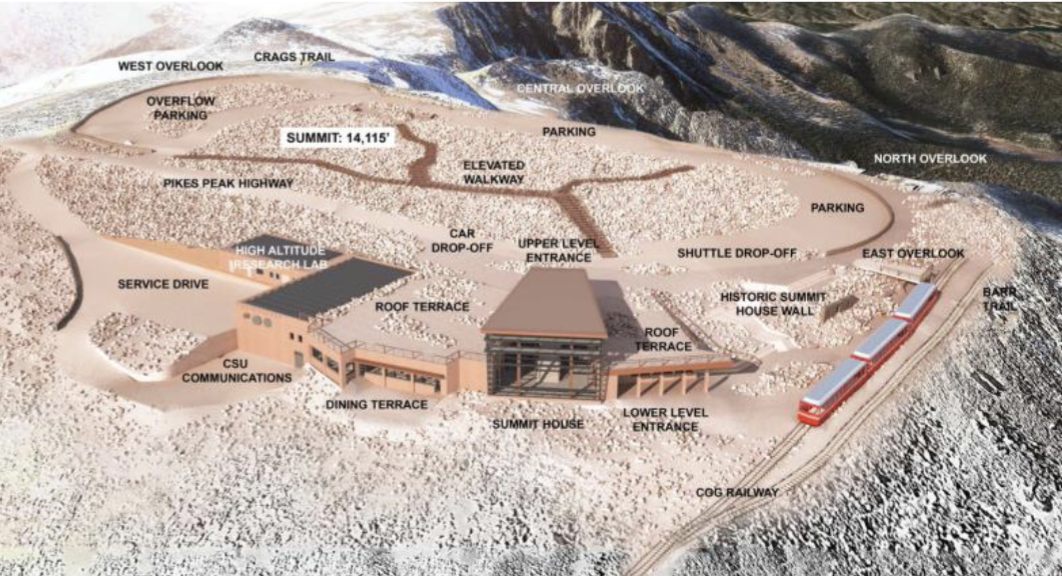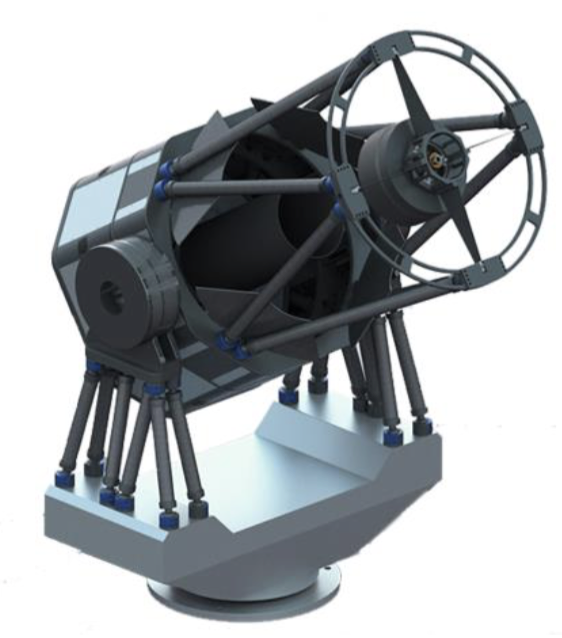 A 501(c)(3) Non-Profit Corporation supporting STEM Education, PPO was established May 28, 1997 “to engage and excite students, teachers, researchers, and the public in science and technology through the exploration and understanding of our environment and the universe” utilizing an observatory with telescopes and instrumentation on the summit of Pikes Peak.
A 501(c)(3) Non-Profit Corporation supporting STEM Education, PPO was established May 28, 1997 “to engage and excite students, teachers, researchers, and the public in science and technology through the exploration and understanding of our environment and the universe” utilizing an observatory with telescopes and instrumentation on the summit of Pikes Peak.
In 1998, an observatory was part of the Summit House design. This plan was shelved to allow paving of the Pikes Peak Highway to the summit, completed in 2011. A new Summit Complex design was developed and presented to the public in January 2016.
 Today, PPO proposes a 1-meter research-quality observatory telescope offering 600,000 annual visitors to the Peak an unmatched educational experience with public viewing and interpretive exhibits that celebrate astronomical and atmospheric research on the peak, past, present, and future. The Observatory can be visited by tourists during the day and operated remotely from Colorado Springs or other locations, day or night, supporting research and contributing to the education and research missions at the Air Force Academy, Colorado College, Denver University, and the University of Colorado.
Today, PPO proposes a 1-meter research-quality observatory telescope offering 600,000 annual visitors to the Peak an unmatched educational experience with public viewing and interpretive exhibits that celebrate astronomical and atmospheric research on the peak, past, present, and future. The Observatory can be visited by tourists during the day and operated remotely from Colorado Springs or other locations, day or night, supporting research and contributing to the education and research missions at the Air Force Academy, Colorado College, Denver University, and the University of Colorado.
The observatory will use a clamshell dome with a viewing platform for the benefit of summit visitors, and will allow both astronomical and atmospheric science data collection.
PPO is working with the City of Colorado Springs to evaluate siting options on the Peak and prepare a US Forest Service special use permit application to build and operate the observatory synergistic with the new Summit Complex design.
 Pikes Peak has been validated for high quality
observing by independent research, based on
limited cloud cover, low water vapor, central U.S.
location, and accessibility. PPO will be operated
by authorized users via remote tasking, creating national and international scientific connections to Pikes Peak. Key PPO beneficiaries will be students who gain hands-on experience tasking PPO and collecting data to support their studies and research. Private citizens can also task PPO in support of their interests.
Pikes Peak has been validated for high quality
observing by independent research, based on
limited cloud cover, low water vapor, central U.S.
location, and accessibility. PPO will be operated
by authorized users via remote tasking, creating national and international scientific connections to Pikes Peak. Key PPO beneficiaries will be students who gain hands-on experience tasking PPO and collecting data to support their studies and research. Private citizens can also task PPO in support of their interests.
PPO will provide the advantages of state-of-the-art technology in meter-class telescopes and fully automated remote operation without needing fulltime presence of personnel on-site. The proposed design minimizes the observatory footprint (minimizing impact to the site) while still allowing unprecedented visitor access. PPO will contribute to the mountaintop experience for visitors who drive up Pikes Peak highway, hike up trails to the summit, or who are passengers on the Cog Railway. Source: https://parks.coloradosprings.gov/parks-recreation- and-cultural-services/page/pikes-peak-summit-complex-project
 An open truss 1-meter observatory telescope as depicted here will facilitate public viewing of the elements of a telescope, and enhance its use supporting science, technology, engineering and math (STEM) education, inspiring students to pursue advanced education leading to careers in STEM disciplines as part of the US technology workforce. The telescope will have a fast tracking capability, permitting it to track asteroids, the international space station, and satellites in earth orbit. An additional hydrogen-alpha solar telescope will be co-mounted with the telescope for daytime solar observation. Imagery from both of these telescopes can be transmitted for display in the Summit Building or to off-site locations.
An open truss 1-meter observatory telescope as depicted here will facilitate public viewing of the elements of a telescope, and enhance its use supporting science, technology, engineering and math (STEM) education, inspiring students to pursue advanced education leading to careers in STEM disciplines as part of the US technology workforce. The telescope will have a fast tracking capability, permitting it to track asteroids, the international space station, and satellites in earth orbit. An additional hydrogen-alpha solar telescope will be co-mounted with the telescope for daytime solar observation. Imagery from both of these telescopes can be transmitted for display in the Summit Building or to off-site locations.
A smaller telescope will be incorporated into the Mobile Earth and Space Observatory (MESO) currently under development. MESO is a “science center on wheels” to engage and excite students, teachers, and local residents with hands-on educational and research activities focused on weather, climate, space sciences, renewable energy, and scientific instrumentation. Geared primarily to middle school students and aligned with science education standards, the mobile lab will visit Colorado schools to deliver formal and informal STEM education, engaging students, teachers and the public.

MESO will also include a weather station, weather balloon, photovoltaic panels, and satellite connectivity for remote tasking of the MESO or PPO telescope, along with a transportable planetarium, digital globe, and curriculum Developed in collaboration with other like-minded organizations, the mobile lab will extend PPO outreach to underserved communities, and educate the general public at events throughout Colorado. A fleet of mobile labs is envisioned which will expand our outreach to additional schools.
When fully realized, Pikes Peak Observatory will ignite sparks in students to pursue studies and seek careers in STEM disciplines meeting the technology workforce demands of Colorado and our nation.
Download the PDF